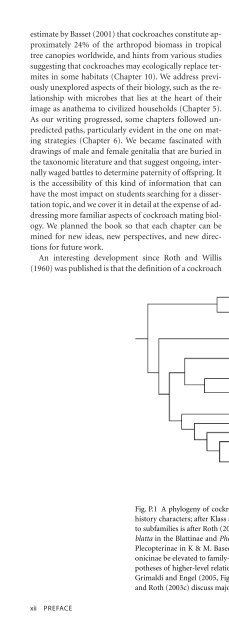Cockroache; Ecology, behavior & history - W.J. Bell
Cockroache; Ecology, behavior & history - W.J. Bell
Cockroache; Ecology, behavior & history - W.J. Bell
You also want an ePaper? Increase the reach of your titles
YUMPU automatically turns print PDFs into web optimized ePapers that Google loves.
estimate by Basset (2001) that cockroaches constitute approximately<br />
24% of the arthropod biomass in tropical<br />
tree canopies worldwide, and hints from various studies<br />
suggesting that cockroaches may ecologically replace termites<br />
in some habitats (Chapter 10). We address previously<br />
unexplored aspects of their biology, such as the relationship<br />
with microbes that lies at the heart of their<br />
image as anathema to civilized households (Chapter 5).<br />
As our writing progressed, some chapters followed unpredicted<br />
paths, particularly evident in the one on mating<br />
strategies (Chapter 6). We became fascinated with<br />
drawings of male and female genitalia that are buried in<br />
the taxonomic literature and that suggest ongoing, internally<br />
waged battles to determine paternity of offspring. It<br />
is the accessibility of this kind of information that can<br />
have the most impact on students searching for a dissertation<br />
topic, and we cover it in detail at the expense of addressing<br />
more familiar aspects of cockroach mating biology.<br />
We planned the book so that each chapter can be<br />
mined for new ideas, new perspectives, and new directions<br />
for future work.<br />
An interesting development since Roth and Willis<br />
(1960) was published is that the definition of a cockroach<br />
Fig. P.1 A phylogeny of cockroaches based on cladistic analysis of 175 morphological and life<br />
<strong>history</strong> characters; after Klass and Meier (2006), courtesy of Klaus Klass. Assignation of genera<br />
to subfamilies is after Roth (2003c) and differs somewhat from that of K & M, who place Archiblatta<br />
in the Blattinae and Phoetalia in the Epilamprinae. Pseudophyllodromiinae used here is<br />
Plecopterinae in K & M. Based on their results, K & M suggest that Lamproblattinae and Tryonicinae<br />
be elevated to family-level status. Mukha et al. (2002, Fig. 2) summarize additional hypotheses<br />
of higher-level relationships. Phylogenetic trees of Vrs˘anský et al. (2002, Fig. 364) and<br />
Grimaldi and Engel (2005, Fig. 7.60) include fossil groups. Lo et al. (2000), Klass (2001, 2003),<br />
and Roth (2003c) discuss major issues.<br />
is somewhat less straightforward than it used to be. <strong>Cockroache</strong>s<br />
are popularly considered one of the oldest terrestrial<br />
arthropod groups, because insects with a body plan<br />
closely resembling that of extant Blattaria dominated the<br />
fossil record of the Carboniferous, “The Age of <strong>Cockroache</strong>s.”<br />
The lineage that produced extant cockroaches,<br />
however, radiated sometime during the early to mid-<br />
Mesozoic (e.g., Labandeira, 1994; Vršanský, 1997; Grimaldi<br />
and Engel, 2005). Although the Carboniferous fossils<br />
probably include the group that gave rise to modern<br />
Blattaria, they also include basal forms of other taxa.<br />
Technically, then, they cannot be considered cockroaches,<br />
and the Paleozoic group has been dubbed “roachoids”<br />
(Grimaldi and Engel, 2005), among other things. Recent<br />
studies of extant species are also blurring our interpretation<br />
of what may be considered a cockroach. Best evidence<br />
currently supports the view that termites are nested<br />
within the cockroaches as a subgroup closely related to<br />
the cockroach genus Cryptocercus. We devote Chapter 9<br />
to developing the argument that termites evolved as eusocial,<br />
juvenilized cockroaches.<br />
Roth (2003c) recognized six families that place most<br />
cockroach species: Polyphagidae, Cryptocercidae, Noctixii<br />
PREFACE


